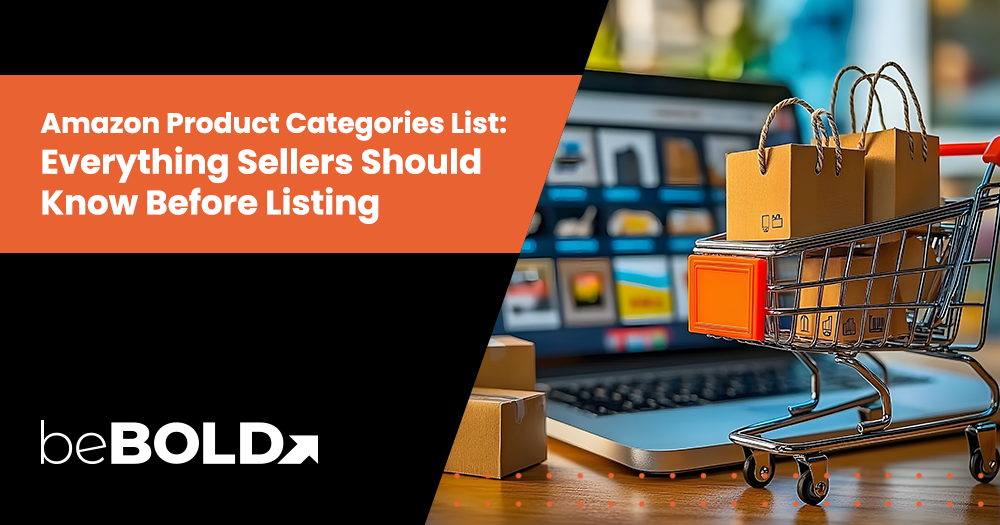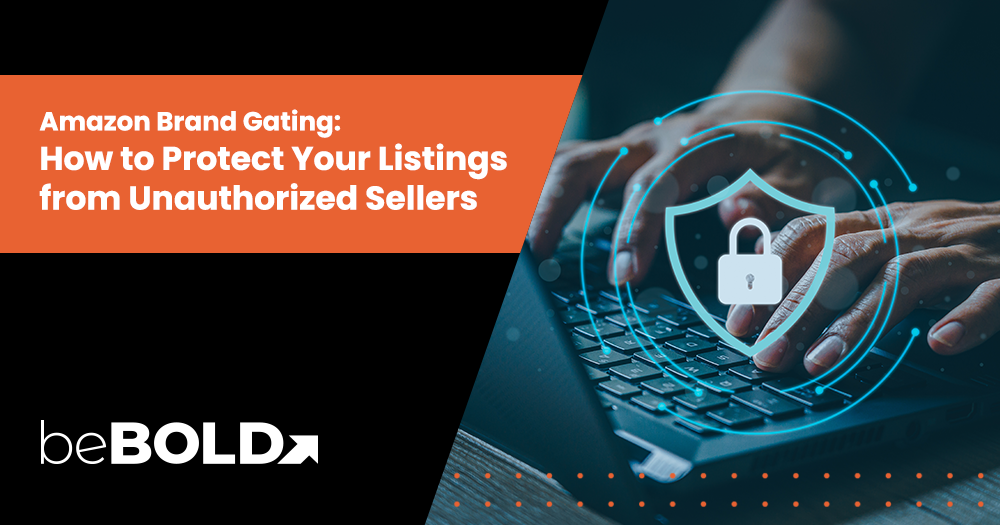This guide explains Amazon’s full product category list, referral fees, approval requirements, and best practices for choosing the right category, helping sellers avoid compliance issues and maximize visibility.
Key Summary
- Amazon currently has around 30–33 main shopping categories, and more than 25,000 subcategories (browse nodes) that influence visibility, filters, and relevance. Selecting the exact node and product type is a major SEO advantage. 🗂️
- Referral fees differ across categories, with most averaging around 15%, electronics closer to 8%, and apparel often higher. Fee categories do not always match storefront categories, so it is important to verify fees in Seller Central. 💰
- Several categories such as Collectibles, Jewelry, Watches, Gift Cards, and Major Appliances frequently require Amazon approval. Gating can also happen at the brand or ASIN level, so sellers should always check “Add a Product → Show limitations.” 🔒
- Categories like Beauty, Pet Supplies, and Health/Household require especially accurate node placement and complete attributes. Doing this improves eligibility for filters, strengthens relevance, and enhances ad performance. 🛒
Amazon Categories List (With Quick Notes)

Source: Adobe Stock
Amazon’s product categories are the backbone of how shoppers browse and how Amazon organizes millions of ASINs. Each top-level category represents a broad department, but within them are thousands of subcategories (browse nodes) that influence visibility, eligibility for filters, and even advertising options. Understanding this structure helps sellers place products more strategically, avoid compliance missteps, and improve discoverability.
- Amazon Device Accessories – This category is device-specific, and sellers must pay close attention to compatibility claims to ensure accuracy.
- Amazon Kindle – This category covers digital content, and it is programmatically different from third-party retail products.
- Automotive & Powersports – This category requires accurate fitment data, and approval is often required for certain parts.
- Baby Products (excluding apparel) – This category has a high safety and labeling standard, and products benefit from strong repeat-purchase dynamics.
- Beauty – This category is compliance sensitive due to ingredients and labeling, and it relies heavily on variations like shades and sizes.
- Books – This category carries media closing fees, and it is ideal for bundles or book series.
- Camera & Photo – This category depends on accurate specifications and compatibility fields that influence search filters.
- Cell Phones & Accessories – This category experiences a rapid product lifecycle, and accessory node placement is critical for advertising.
- Collectible Coins – This category has strict authenticity requirements and is typically gated.
- Consumer Electronics – This category often has lower referral fees in many subcategories, but it carries a high risk of returns.
- Entertainment Collectibles – This category has strict verification standards and is usually gated.
- Fine Art – This is a curated category that is approval heavy.
- Grocery & Gourmet Foods – This category requires shelf-life, labeling, and temperature compliance.
- Health & Personal Care – This category is compliance led, with strict requirements for claims and documentation.
- Home & Garden – This category is very broad, so sellers should push to list in the most specific sub-node possible.
- Independent Design – This program category is selective, and availability varies.
- Industrial & Scientific – This category has B2B potential, and Amazon Business features are often helpful here.
- Kindle Accessories & Amazon Fire TV Accessories – This category is tied specifically to Amazon devices.
- Major Appliances – This category often requires approval and documentation, and logistics can be challenging.
- Music and DVD – This media category involves rules and closing fees, and many subnodes are gated.
- Musical Instruments – This category requires careful planning due to product size and fragility.
- Office Products – This category overlaps strongly with Amazon Business buyers.
- Outdoors – This category has seasonal demand swings, so sellers should plan around subcategory seasonality.
- Personal Computers – This category has a different fee structure, and detailed specifications influence search filters.
- Pet Supplies – This category benefits from high repeat purchase behavior, but product safety is a priority.
- Software – This category requires clarity around licensing.
- Sports – This is a broad category, and sellers should distinguish Sports Collectibles separately.
- Sports Collectibles – This category requires authentication and approval.
- Tools & Home Improvement – This category depends heavily on specifications and compatibility for discoverability.
- Toys & Games – This category has seasonal demand and strict compliance requirements for age grades and testing.
- Video, DVD & Blu‑ray – This media category is governed by strict policies, and many subnodes are gated.
- Video Games – This category includes both digital and physical programs, which sellers should differentiate.
- Watches – This category often requires approval, and fee tiers may differ depending on product valuation.
Amazon’s categories reflect the way shoppers naturally browse, search, and make purchase decisions on Amazon. For sellers, the most important step is selecting the precise Product Type and browse node. This ensures accurate classification and compliance, while also unlocking essential attributes that improve product discoverability. Choosing the right category path makes your listings eligible for search filters, strengthens your organic SEO, and boosts the relevance of your PPC campaigns, directly impacting visibility and sales.
And because visibility is closely tied to conversion signals, it also helps to understand how Amazon rewards optimized, high-performing listings. For a deeper breakdown of how these factors influence trust and ranking, take a look at our guide: “Amazon’s Choice Badge Explained: What It Means & How to Get It.”
If you want deeper insight into how consumers think, browse, and react during major shopping events, take a look at Psychology of Black Friday: Consumer Behavior, Statistics & Trends.
What Are the Referral Fees for Each Category?
Referral fees are the percentage Amazon charges for each sale, and they vary by category. While most categories sit around 15%, some are lower or higher depending on the type of product. Here is a simplified look at common categories based on Amazon’s published fee structure:
|
Category |
Typical Referral Fee (US) |
|
Home & Kitchen |
~15% |
|
Beauty & Personal Care |
~15% |
|
Clothing, Shoes & Jewelry |
~17% |
|
Toys & Games |
~15% |
|
Health & Household |
~15% |
|
Electronics |
~8–15% depending on subcategory |
|
Sports & Outdoors |
~15% |
|
Pet Supplies |
~15% |
|
Office Products |
~15% |
|
Grocery & Gourmet Food |
~8–15% depending on item |
|
Books & Media |
~15% + closing fee |
|
Jewelry |
~20% (often higher) |
|
Watches |
~16% |
|
Automotive & Powersports |
~12–15% |
Note: These are typical referral fees, but exact rates depend on the fee category Amazon assigns to your ASIN and sometimes on product price tiers. Always confirm the current fees in Amazon Seller Central before finalizing pricing.
What Is the Most Profitable Category on Amazon?
There’s no single winner. Profitability hinges on COGS, competition, CPCs, return rate, and LTV. Still, some categories combine strong demand with manageable competition and healthy margins, especially when you niche down to specific nodes.
High‑Demand Amazon Categories
|
Category |
Why Sellers Like It |
|
Home & Kitchen |
Huge demand and endless product variety, though competition is fierce. |
|
Beauty & Personal Care |
High repeat‑purchase potential and strong growth in online shopping. |
|
Clothing, Shoes & Jewelry |
Constant demand with opportunities for unique styles, but returns can be high. |
|
Toys & Games |
Seasonal spikes, especially during holidays, with consistent year‑round sales. |
|
Health & Household |
Everyday essentials that keep customers coming back. |
|
Electronics |
Strong sales volume and innovation, though margins can be tighter. |
|
Sports & Outdoors |
Popular year‑round, with seasonal surges tied to activities. |
|
Pet Supplies |
Growing category driven by loyal pet owners and repeat purchases. |
|
Office Products |
Steady demand from both consumers and business buyers. |
beBOLD Tip: If your products include liquids, aerosols, or batteries, don’t skip our Amazon Dangerous Goods Program guide to ensure smooth FBA approval.
Amazon Categories Requiring Approval (Gated)
![]()
Source: Adobe Stock
Not every Amazon category is open to sellers by default. Amazon places additional restrictions on certain high‑risk or sensitive product areas to protect customers and maintain trust. These are known as gated categories, and they require sellers to go through an approval process, provide extra documentation, or meet performance standards before listing.
Common examples of categories that are often gated include:
- Automotive & Powersports – This category usually requires documentation and accurate fitment data to ensure safety and compliance.
- Collectibles – This includes coins, fine art, old movies, and sports memorabilia, all of which demand strict authenticity verification.
- Gift Cards – Due to fraud risks, this category is tightly controlled and requires direct approval from Amazon.
- Major Appliances – Items such as refrigerators and dishwashers often require approval and may have specific shipping or safety requirements.
- Jewelry and Watches – These high‑value items typically fall under approval processes to verify authenticity and quality.
- Media Products (Video, DVD, Blu‑ray, and Music) – Many of these subcategories are also restricted and need additional approval.
Other categories may also have restrictions at the subcategory or ASIN level. For example, Beauty, Grocery, or Health products sometimes require additional documentation even if the parent category appears open.
Always confirm in Amazon’s official Categories & products that require approval help page and by using Add a Product → Show limitations for the specific ASIN or node before investing in inventory. Policies are updated frequently, so checking early prevents costly delays.
beBOLD Tip: If you're selling in Grocery or consumable categories, you may also find our guide on How to Sell Food on Amazon helpful for understanding requirements and best practices.
How to Find the Right Category for Your Amazon Product
Selecting the right category is one of the most important decisions a seller can make when listing on Amazon. It impacts everything from organic visibility to whether your product shows up in search filters and what compliance requirements apply. Getting this step wrong can hurt discoverability, delay approvals, or even risk account flags. Here’s a practical workflow to approach category selection strategically:
- Reverse‑engineer top performers. Search your primary keyword, open top ASINs, and inspect the Product Details → Best Sellers Rank and category path to see where winners live. This helps you learn which nodes Amazon’s algorithm rewards for your target audience.
- Use Category‑Finder tools. In Seller Central, use the Product Classifier (preferred over static BTGs) to select the most precise Product Type and browse nodes. This tool also reveals required attributes, ensuring your product data is complete and compliant.
- Set smart filters in product databases. Narrow by price band, size/weight, sales velocity, and review count, then evaluate nodes with strong demand but less saturation. This reduces competition and improves chances of gaining traction faster. Reviewing Amazon pricing history can also help validate whether the price band you’re targeting has been stable or volatile over time, ensuring your filters lead you to sustainable opportunities.
- Find low‑competition niches. Don’t stop at the parent category—drill into sub‑nodes where search + filter traffic remains healthy but CPCs and review barriers are manageable. These micro‑categories can provide a foothold for newer brands.
When sellers invest time in picking the right node and filling out every required attribute, they not only comply with Amazon’s listing rules but also unlock more opportunities in SEO and advertising. The right category choice can mean the difference between being buried in search results and standing out as a top‑ranked option in a high‑intent shopping path.
beBOLD Tip: Learn how to safeguard your brand reputation—start with “Does Amazon Sell Counterfeit Products?” for practical insights.
Find Your Winning Amazon Category with beBOLD Digital
Your Amazon Product Categories List is more than just a directory—it is a strategic growth lever for your business. By starting with a shopper-facing category and then drilling down into the correct backend structure, you ensure accurate classification, compliance, and visibility. Selecting the right Product Type, most precise browse node, and filling out all required attributes will improve discoverability, protect margins, and strengthen your advertising strategy. Confirming approval status and fee category before you price products will also help you avoid costly delays or missteps. Aligning your PPC targeting with the same category structure amplifies both visibility and profitability over time.
If you want expert assistance in zeroing in on the perfect category and mapping out where your products should live, beBOLD Digital can help. Our team can analyze your catalog, create a tailored guide, and lead you through the approval and optimization process so that you launch in the right place from day one. Contact beBOLD Digital today to get started.
Frequently Asked Questions
How many product categories are there in Amazon?
On Amazon’s U.S. marketplace, you can expect roughly 30 to 33 main categories. The exact names vary depending on how Amazon presents them, and beneath these categories are more than 25,000 subcategories (browse nodes). This deep structure is what really drives product visibility and filtering.
What categories can you sell on Amazon without approval?
Most of the big categories are open, meaning you don’t need approval to start selling. However, approval can still be required at the subcategory, brand, or even ASIN level. For example, categories like Collectibles, Jewelry, Watches, Media, and some Automotive parts often have restrictions. The safest approach is always to use Add a Product → Show limitations in Seller Central to confirm before you list.
Does Amazon require proof of my brand to let me sell?
No, you don’t need to prove you own a brand just to sell on Amazon. Many sellers get started without a registered trademark. But if you want to access premium tools like A+ Content, Brand Analytics, and stronger IP protections through Brand Registry, you’ll need to have a registered or pending trademark and provide Amazon with verification.
Do I need to trademark my brand to sell on Amazon?
You don’t need a trademark to start selling, but you do need one to unlock the advantages of Brand Registry. Many brands begin selling first and then file for a trademark once they see traction, so they can access additional protections and marketing benefits later.
How long does Amazon brand approval take?
The timeline can vary a lot. If you already have a valid trademark and submit clean documentation, Brand Registry approval can be relatively fast. In other cases, Amazon may ask for more information, so expect some back‑and‑forth. It’s best to start the process early if you plan to enroll.
Can I change my Amazon product category after listing?
Yes, you can. If you realize your product is in the wrong category, you can request a category or browse‑node change in Seller Central. For bulk updates, the Add Products via Upload tool is the way to go. Just be ready to justify why the change is more accurate and to meet any new requirements.
Do product categories affect Amazon PPC campaigns?
Definitely. Both Sponsored Products and Sponsored Display allow you to target specific categories. The category and browse node your ASIN sits in affects what targeting options you get and how relevant your ads appear on detail pages. Aligning your listing category with your PPC targeting strategy will make your ad spend more effective.











Comments